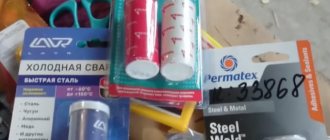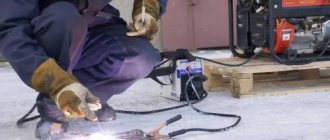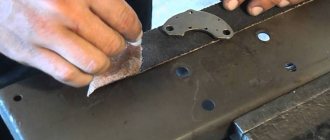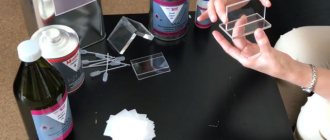The aluminum-silicon alloy is easy to forge and cast. Products made from it are durable, lightweight, corrosion-resistant, and visually attractive.
Simulin is used in many fields of activity:
- mechanical engineering;
- architecture;
- making dishes;
- parts for plumbing and many others.
Its physical properties are compared to steel, but silumin is much lighter. It has a low cost, so it has become more preferable in the production of inexpensive household appliances.
To restore or connect siluminium parts, welding is used. Joining this alloy in practice has a number of difficulties and differs from conventional welding.
Let's talk in more detail about the methods and technology of welding silumin yourself. There are two ways to connect silumin at home:
- argon arc;
- consumable electrodes.
Is it possible to cold weld a radiator?
Small holes can be repaired by cold welding, a fairly reliable epoxy compound. Then you need to close all the radiator outlets and leave one. Connect a compressor to it. Then lower the radiator into a basin of water and look for the crack by the air bubbles that begin to come out.
Interesting materials:
How to create txt file cmd? How to create a txt file on a computer? How to create an XML file in Excel 2016? How to create an XML file in Excel? How to compare two files for identity? How to compare two files for differences? How to compare the contents of two files? How to link Word and Excel files? How to compress a folder with PDF files? How to compress a PDF file instructions?
Brief characteristics of silumin
Silumin is a metal alloy based on aluminum. Cutlery, dishes, containers for storing food, drinking water, sanitary fittings, and building materials are made from it. The main components of the alloy are aluminum and silicon. The content of the second element can reach 22% of the total mass. Additionally, third-party additives may be added to the composition to change the technical characteristics.
Physical, chemical properties:
- Material density - 3g/cm3.
- Melting point - 580 °C.
- High plasticity.
- Low strength.
The popularity of silumin is explained by its main advantage - resistance to rust formation. When exposed to open air, an oxide film appears on metal surfaces, which protects them from environmental factors.
How to use the mixtures?
Those who do not know how to glue aluminum at home should follow the following sequence of actions:
- Rust and dirt are removed from the surface of the joined areas using fine-grained sandpaper or a brush.
- Next, the surfaces are treated with acetone.
- After this, you need to wait a while for the area to dry.
- Mix glue and hardener in a separate container. You should get a homogeneous viscous mass.
- The adhesive mixture must be applied to the surface in the form of dots or thin strips. Then the parts are pressed tightly against each other. They need to be fixed in this position and left for 15-20 minutes.
If you have any excess, you can remove it with a rag previously soaked in solvent.
Principles of gluing silumin
Instructions:
- Clean metal surfaces from dirt, rust, and plaque. This can be done using a metal brush or sandpaper.
- Wipe surfaces with acetone to remove grease film.
- Wait until the treated areas dry. Mix the components of the adhesive composition.
- Apply a thin, even layer of glue to the surface.
- Connect the parts together. Press with your hands, squeeze in a vice or press down with something heavy.
- Wipe off excess adhesive mass with a dry cloth.
The glued part can be used only after 24 hours.
If it is not possible to use welding or there is no practical experience in working with a welding machine, problems arise with choosing a method for connecting metal surfaces to each other. For gluing, you can use special one-component or two-component compounds. It is important to prepare metal surfaces and perform gluing strictly according to the instructions.
Methods for connecting silumin
There are several effective ways to connect parts made of silumin with other materials:
- argon arc welding using special solders;
- cold welding connection;
- gluing with adhesives.
The latter option involves the use of special adhesives that you need to know how to work with.
Welding (Photo: pixabay.com)
Alloy groups
Silumin alloys are divided into several groups. This distinction is made according to the purpose of the materials:
- AK 12 is a eutectic silumin containing 12% silicon. During heat treatment, the casting is not strengthened and does not become hard during shrinkage. Parts made of such material are structurally designed for sealed low-load devices.
- Highly alloyed hypereutectic silumin is labeled, for example, AK4M5. Belongs to the piston group and is used when performing work under high-temperature conditions. It has high resistance to high temperatures and wear resistance. The use of this alloy for particularly important products operating under high load conditions. These are large-sized and critical parts.
Argon welding technology
Before you begin, you need to prepare the equipment. You will need:
- inverter;
- burner with non-consumable electrode;
- gas cylinder;
- oscillator;
- filler wire.
Preparation of parts involves removing the oxide film:
- To do this, sandpaper or other means are used to clean the joints of the parts.
- Next, the edges are treated with any chemical: solvent, caustic soda.
Important! After using caustic soda, be sure to rinse the workpieces with water pressure.
The technology for welding silumin with argon is similar to the process of welding aluminum. This is the most reliable way to connect silumin products.
When connecting parts, they heat up and a high-temperature resistant film is formed, which limits the reliability of the bond. To avoid this, an inert gas, argon, is used. It pushes out air in the welding space, preventing parts from oxidizing.
Requirements for performing work at home:
- It is not recommended to perform work in an open space; the best option would be an enclosed space (a garage or a household extension will do);
- During welding, overheating of the gas must be avoided, otherwise argon will begin to destroy the elements.
- Welding is carried out using a short arc with reverse polarity (connecting the electrode to the plus and the workpiece to the minus). With this method, the product melts easier.
- The filler wire is fed into the work area, where it melts and joins the products.
- The additive must be applied gradually, otherwise there is a high risk of metal splashing, which will lead to a poor connection.
- The additive is supplied at an angle to the burner, the directions are carried out strictly along the seam.
Fulfillment of these conditions guarantees an even and narrow seam.
This video shows how to repair (weld an aluminum pan):
Advantages and disadvantages of argon welding
Advantages of the method:
- This option for connecting elements is considered the most durable.
- Welding does not take much time.
- The technology is suitable even for beginners.
- The welding process can be done at home.
- Deformation of parts is excluded.
Minuses:
- It is impossible to carry out work outdoors; the wind will interfere with the correct distribution of gas over the working surface.
- The need to have special equipment.
- There is a high probability of difficulty in settings.
- If the work is carried out by a transformer with a high current strength, then cooling will be required.
Welding at home requires compliance with safety precautions. During work, use protective equipment, wear:
- special clothes;
- mask;
- gloves;
- shoes with rubber soles.
Carry out work to insulate all conductive elements. Avoid the presence of flammable objects near the work area. The room must be well ventilated.
Gluing or welding silumin?
From time to time I encounter the destruction of silumin elements. Externally, parts made of silumin look like aluminum, but this is only at first glance. Although it is quite easy to distinguish when the product is damaged. With the naked eye you can see sintered grains of powder. But, as they say, hope dies last. In the phone book you look for the number of a familiar argon engineer. You bring the part and after the first “chvark” you can see the sour face of this argon worker. And now, after further damage to the silumin parts, I no longer want to attempt to contact argon specialists.
And so I decided to google on the Internet to see if this same silumin can really be welded. First, I look at Wikipedia to find out what this silumin consists of. Its similarity to aluminum is not accidental, since this is the main component of this alloy. The second main element is silicon, the share of which ranges from 4 to 22% depending on its brand. Silumin also contains a small amount of impurities: iron, copper, manganese, titanium and others. Based on the fact that the percentage of silicon is different, then most likely there is a chance of welding. So, having immersed myself in heated discussions on Internet forums, I realized the following: welding (soldering) is only worth it if the part is of some value and if it is under the influence of certain loads. Otherwise, everyone advocates gluing silumin parts together. OK. Still, I would like to briefly outline the basic requirements for welding.
- Use only argon.
- Silumin can be different. We must always try. Frankly, Chinese products are not welded. They melt down stupidly. But, for example, automobile parts from well-known manufacturers can be welded without problems.
- To weld silumin, it is recommended to use special solders such as Harris-52, HTS-2000, ER 4043. They are intended for welding aluminum.
- Before welding, the parts must be preheated to a temperature of 220 degrees Celsius. For more efficient heat removal, it is recommended to use steel gaskets. As far as I understand, this is necessary to prevent silumin from melting.
- Try to avoid rigid fastenings to avoid crack formation.
- Try it on a test piece before welding.
Now as for gluing silumin. Before gluing it is necessary to carefully prepare the surface. Clean as much dirt and oil as possible. Think in advance about how to fix the products after applying the glue. The most common adhesive is epoxy. Also, many recommend all sorts of five-minute exercises. After the glue has hardened, you can reinforce the gluing areas. Fiber-filled putty is suitable for these purposes. Yes, if you are hoping to find a special glue for silumin, do not waste your time. But here you can follow the logic of welders who are looking for solders for aluminum. So here, there are special adhesives designed for gluing aluminum. Two-component adhesives COSMOFEN DUO and AL-1. Used in construction for gluing aluminum elements of windows and doors.
Here is a brief analysis to help those who are looking for ways to weld and glue silumin. Here the approach must be creative, when the sum of attempts gives rise to victory. Good luck. PS I completely forgot about “cold welding”.
Types of glue for silumin
For gluing, it is better to use special polyurethane or resin adhesives. Each of them has certain features that need to be studied before using them.
Polyurethane adhesive for silumin
Types of compositions:
- One-component. The basis of the composition is polyurethane polymer. No solvent is supplied with it. Such adhesives are suitable for use on exposed parts of products. In order for the glue to react with the material, the surfaces must be moistened with a small amount of water.
- Two-component. A special hardener is added to the polyurethane base. Metal surfaces do not need to be wetted before applying the adhesive.
In the second option, you need to mix the two components and apply the mixture to the joint.
Resin glue for silumin
To make a strong connection that will be resistant to high temperatures, it is better to choose a two-component adhesive composition based on epoxy resin. They are suitable for joining metal, plastic, stone, porcelain, wood.
Kinds:
- Cold hardening. For the adhesive mass to dry, a temperature of 15–35°C is required.
- Hot solidification. Used by industrial enterprises. To harden, the adhesive mass must be heated to 100 °C.
To start working with epoxy resin glue, you need to mix two components in certain proportions.
Figures made of silumin (Photo: pixabay.com)
Solders for aluminum
Aluminum can be soldered with both ordinary lead-tin solders and special ones containing aluminum, zinc, silver and other metals and even non-metals (for example, silicon). POS solders, like those special for aluminum, have different melting temperatures, which must be taken into account both when working with them and when operating the repaired product.
If you decide to solder dishes that come into contact with food (canister, flask, distiller tube, etc.), then solders containing lead cannot be used. You will have to do high temperature soldering , using, for example, 34A solder, containing copper, silicon and, of course, aluminum. TsOP-40 containing zinc is suitable.
Solders 34A (left) and TsOP-40
Among the foreign ones, we can recommend Aluminum-13, which, in fact, is an analogue of 34A.
Solder for soldering aluminum Aluminum-13
Another option is soldering with pure tin. It is great for repairing food utensils and has a low melting point, which means the work can be done with a soldering iron. But when using tin, make sure that the soldering area does not get too hot during the operation of the product. For example, you can seal the bottom of a kettle with tin (it comes into contact with water and will not heat up above 100 degrees), but the beak of the same kettle will fall off after the first boil.
Tin can be used to solder food utensils
The so-called fluxed ones, which already contain a special flux (usually in the form of a coating, but not necessarily), deserve special attention. There is an opinion that flux is not needed at all to work with them and, in principle, this is true. Nevertheless, it is very desirable for protecting the soldering area from oxidation during operation. Any passive flux that can withstand soldering temperatures is suitable for these purposes. The ideal solution here would be ordinary transformer oil, which electricians use when soldering high-voltage couplings.
How can you glue aluminum and glass?
How and with what to glue metal to glass
- Two-component epoxy adhesive. ...
- Silicone with high thermal stability. ...
- A product called Moment Crystal. ...
- Automotive adhesive resembles rubber in its basic characteristics.
Interesting materials:
How to care for a store-bought rose in a pot? How to care for small roses? How to care for a mini rose? How to care for a climbing rose in the country? How to care for Climbing Rose in the first year? How to care for a purchased rose in a pot? How to care for a purchased rose? How to care for roses from the store? How to care for roses after planting in spring? How to care for roses after planting?










